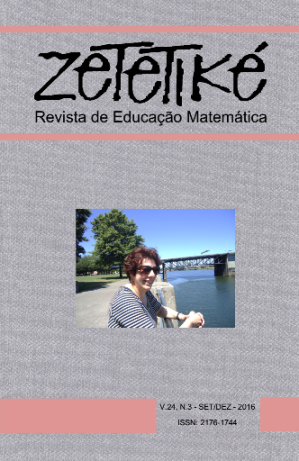Abstract
In this article, we present partial report of a survey conducted with 15 students of Mathematics Teacher Training
courses at two higher education institutions of Rio Grande do Sul, Brazil. The purpose of this research is to
analyze difficulties encountered by undergraduate mathematics to solve a question about sequences. As a
research tool, it was used a test composed of a question of numerical sequence, the answers were corrected
using the following categories: correct, partially correct, incorrect and no answer. The analysis was made by
description and comments of responses, based on theories about the three worlds of mathematics. In general, it
appears that the participants present difficulties, both conceptual and procedural, related to the concept of limit
of a sequence and seems to be still in the stages of practice and theoretical mathematics, without reaching the
stage of formal mathematics.
References
Attorps, I. (2006). Mathematics teachers´conceptions about equations. Tese de Doutorado em Educação. Faculty of Behavioural Sciences, University of Helsinki.
Badaró, J. N. & Lima, R. N. (2011). Uma jornada pela história do símbolo de igualdade com os três mundos da matemática. Atas da XIII Conferência Interamericana de Educação Matemática. Recife, Brasil.
Ball, D. L., Thames, M. H. & Phelps, G. (2008). Content knowledge for teaching: what makes it special? Journal of Teacher Education, 59 (5), 389-407.
Barichello, L. (2008). Análise de resoluções de problemas de cálculo diferencial em um ambiente de interação escrita. Dissertação de Mestrado em Educação Matemática. Rio Claro, Instituto de Geociências e Ciências Exatas, Universidade Estadual Paulista.
Borasi, R. (1996). Reconceiving mathematics Instruction: a Focus on Errors. Norwood, NJ: Ablex Publishing Corporation.
Brasil, Ministério da Educação, Conselho Nacional de Educação. (2015). Resolução nº 2, de 1º de julho de 2015. Define as Diretrizes Curriculares Nacionais para a formação inicial em nível superior (cursos de licenciatura, cursos de formação pedagógica para graduados e cursos de segunda licenciatura) e para a formação continuada. Retirado em 25 de novembro, 2016, de: http://den.prograd.ufsc.br/files/2016/07/2.7.DiretrizesLicenciatura2015_ResolucaoCNECP2_2015.pdf
Cury, H. N. (2007). Análise de erros: o que podemos aprender com as respostas dos alunos. Belo Horizonte: Autêntica.
Ferreira, L. (2011). Uma proposta de ensino de geometria hiperbólica: construção do “plano de Poincaré” com o uso do software Geogebra. Dissertação de Mestrado em Educação para a Ciência e a Matemática. Maringá: Universidade Estadual de Maringá.
Fiorentini, D. & Oliveira, A. T. de C. C. (2013). O lugar das matemáticas na Licenciatura em Matemática: que matemáticas e que práticas formativas? BOLEMA, 27 (47), 917-938.
Gray, E. M. & Tall, D. (1994). Duality, ambiguity and flexibility: a proceptual view of simple arithmetic. The Journal for Research in Mathematics Education, 16 (2), 115-141.
Hardy, N. (2009). Students’ perceptions of institutional practices: the case of limits of functions in college level Calculus courses. Educational Studies in Mathematics, 72 (3), 341-358.
Kieran, C. (1981). Concepts associated with the equality symbol. Educational Studies in Mathematics, (12), 317-326
Lima, E. L. (1999). Análise real. 4. ed. Rio de Janeiro: IMPA. v. 1.
Lima, R. N. (2007). Equações algébricas no ensino médio: uma jornada por diferentes mundos da matemática. Tese de Doutorado em Educação Matemática. São Paulo: Pontifícia Universidade de São Paulo.
Lima, R. N. & Tall, D. (2008). Procedural embodiment and magic in linear equations. Educational Studies in Mathematics, (67), p. 3-18, 2008.
Mação, D. P. (2014). Uma proposta de ensino para o conceito de derivada. Dissertação de Mestrado em Educação Matemática. São Paulo: Universidade Anhanguera de São Paulo.
Malta, I., Pesco, S. & Lopes, H. (2002). Cálculo a uma variável: uma introdução ao Cálculo. Rio de Janeiro: PUC-Rio; São Paulo: Loyola. v. 1.
Moreira, P. C. & Ferreira, A. C. (2013). O lugar da Matemática na Licenciatura em Matemática. BOLEMA, 27 (47), 981-1005.
Nomura, J. I. (2014). Esquemas cognitivos e mente matemática inerentes ao objeto matemático autovalor e autovetor: traçando diferenciais na formação do engenheiro. Tese de Doutorado em Educação Matemática. São Paulo: Pontifícia Universidade Católica de São Paulo.
Ponte, J. P., Branco, N. & Matos, A. (2009). Álgebra no ensino básico. Lisboa: Ministério da Educação.
Ramos, M. L. P. D. & Curi, E. (2014). O uso do erro como estratégia didática: uma nova perspectiva na reconstrução do conhecimento. Perspectivas da Educação Matemática, Campo Grande, 7 (13), 84-102.
Santos, J. R. V., Buriasco, R. L. C. & Ciani, A. B. (2008). Avaliação como prática de investigação e análise da produção escrita em matemática. Revista de Educação, (25), 35-45.
Shulman, L. S. (1986). Those who understand: knowledge growth in teaching. Educational Researcher, 15 ( 2), 4-14.
Shulman, L. S. (1987). Knowledge and teaching: foundations of the New Reform. Harvard Educational Review, 57 (1), 1-22.
Stewart, J. (2001). Cálculo. São Paulo: Pioneira. v. 2.
Tall, D. (2004). Thinking through three worlds of mathematics. Proceedings of the 28th Meeting of the International Conference for the Psychology of Mathematics Education. Bergen, Norway. p. 281-288.
Tall, D. (2013). How Humans Learn to Think Mathematically: Exploring the Three Worlds of Mathematics. New York: Cambridge University Press.
Tall, D. & Vinner, S. (1981). Concept image and concept definitionin mathematics with particular reference to limits and continuity. Educational Studies in Mathematics, (12), 151–169.
Trivilin, L. R. & Ribeiro, A. J. (2015). Conhecimento matemático para o ensino de diferentes significados do sinal de igualdade: um estudo desenvolvido com professores dos anos iniciais do ensino fundamental. BOLEMA, 29 (51), 38-59.
Zubieta, G. & Meza, R. (2008). Visualization in the teaching/learning of calculus. Proceedings of the 11th International Congress on Mathematical Education. Monterrey, Mexico. Retirado em 09 de março, 2016, de: http://tsg.icme11.org/tsg/show/21

This work is licensed under a Creative Commons Attribution-NonCommercial-NoDerivatives 4.0 International License.
Copyright (c) 2017 Zetetike

